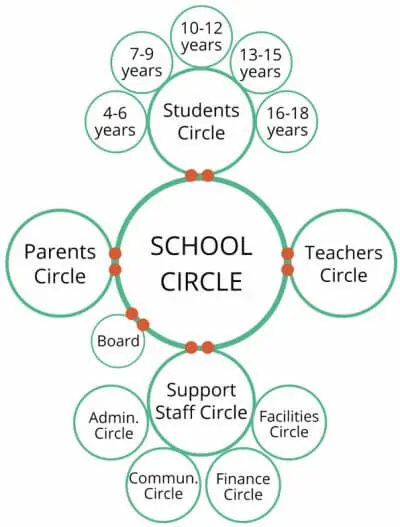Originally published at: https://www.sociocracyforall.org/teachers-unions-using-sociocracy/
Taking teachers’ unions one step further using sociocracy
Teachers’ unions are meant to empower teachers through collective bargaining. However, this can sometimes lead to an adversarial relationship between teachers and administrators. For example, if teachers feel the need to strike to get their needs met, the relationship with administrators can be damaged.

Adversarial collective bargaining has been the norm of the relationship between teachers’ unions and administrators in the United States for three decades, and the traditional industrial union model has been seen as promoting a competitive scenario where there is no collaboration between the constituents.”
(Urbanski, 2003, as cited in Quinn, 2003)(Baker, Berg &Schiro)
Instead of adversarial unions that pit teachers vs. administrators, everyone can benefit by bringing everyone to the decision-making table. Sociocracy, a form of self-governance using consent-decision making, can create a container for both the needs of the administration and the teachers. Compromises can be made that are beneficial for all. Using sociocracy may even help to prevent a teachers’ strike as their needs may already be met.
If a strike does occur, the repair process “...is easier if principals have created collaborative work environments in which teachers’ views are valued and working conditions are addressed.” The tools in sociocracy can help create this kind of collaborative environment.
Sociocracy as a solution for teacher’s unions
In the governance process of sociocracy, all stakeholders come to the table for a thoroughly collaborative process. Schools using sociocracy still have power delegated to leaders such as a principals. Power is also shared through a structure with committees called “circles” that bring all stakeholders to the table. Circles are all connected, and each circle has a certain area of decision-making responsibility.
Teachers’ circles as teachers’ unions
Schools often have “staff circles” or “teacher’s circles” that represent the needs of the teachers, as unions would. The teachers’ circle might be able to independently decide things like how to stock the teachers’ lounge, or how to organize curriculum. However, proposals from the teacher’s circle that affect the budget or school policies might need consent at a higher level. These decisions would include the principal as well as representatives from the teachers’ circle.
Consent decision-making: is it good enough for now?
In consent decision-making, a proposal is put forth, and objections are gathered. Anyone in a circle can object to the proposal with a reason why the proposal is not good enough, or safe enough to try. This is different from a majority vote, or from a veto where one person can stop the whole process. Instead, the group seeks to find a way to address the objection so that everyone is OK with the proposal moving forward. Because everyone’s concerns have been heard and integrated, everyone is invested in the proposal. A limited trial period helps to test the proposal and change it if needed.
Working with consent and objections, administrators and teachers are on the same team.
What kinds of decisions do teachers make using sociocracy?
Teacher input on hiring and firing at Rainbow Community School
“They fired who?!”
Rainbow Community School is a Waldorf school in Asheville, NC which adopted sociocracy in a top-down manner. Right after the implementation of sociocracy, there was a round of budget cuts. The director at the time, Renee Owen, decided to lay off three teachers. One of the teachers who was let go was a beloved storyteller who had been at the school for a long time. The other teachers were angry that they weren’t included in the process. Renee was very reluctant to completely hand over hiring and firing decisions. However, she decided to lean into the consent process, trust sociocracy, and see what happened.

Creating a solution together
To form a proposal in sociocracy, everyone asks clarifying questions to help everyone understand the issue at hand.
- First, the teachers took turns speaking in a circle (called “rounds”) asking Renee how hiring worked at the school. She shared stories of complex and delicate situations.
- Second, they did reaction rounds to see how people felt about what was happening. The teachers were able to vent their frustrations, relieving some tension.
- Then they explored ideas that might help include teachers while keeping the process confidential. They came to the conclusion that a large group of people could not be part of these decisions, but they still wanted staff representation.
- They proposed forming a small advisory hiring committee to help the director, who remained the primary decision-maker.
After the committee was proposed, the director realized that nothing would be approved that she didn’t also consent to. This fact helped her relax into the process, and everyone was able to consent to this proposal. The newly formed committee was even able to rearrange the budget to allow the beloved storyteller to return to school!
The process of coming up with a proposal together served the same purpose as a teacher’s union, representing the needs, feelings, and opinions of the teachers to the administration.
Sick leave and vacation pay at Pathfinder Community School

“I’m tired of unpaid sick leave.” “But we just can’t afford it!”
I was once in a meeting at the now-closed Pathfinder Community School in Durham, NC with a staff circle serving the same function as a teachers’ union. The director brought in a generous proposal to increase sick leave and vacation pay. The administrator in charge of managing the budget didn’t know about the proposal and became quite upset. As the caretaker of the school budget, the administrator had a hard objection to the proposal, and wouldn’t budge. The staff, on the other hand, loved the proposal. They became emotional as well because they were tired of unpaid sick leave. They needed to take care of their families, and felt that the current policy was not supportive enough.
As the reasons for the feelings became clear, things cooled down. A solution was suggested to send the proposal back to the financial circle to calculate how much sick leave and vacation pay would actually cost. The circle was asked to take staff needs into consideration and to try to be as generous as possible. The circle took the time to calculate the sums, and it turned out to be to be a very small percentage of the overall budget. There was enough to give teachers at least a few days of both sick leave and vacation pay, though not as much as had been asked for. At the next meeting, the amended proposal which addressed both budgetary concerns and staff needs was consented to.
The process of integrating objections in sociocracy helped to resolve the conflict.
A school-wide teachers’ union: everyone on the same team

Teachers’ unions can be formed at the school-wide level using sociocracy. Sociocracy brings everyone to the same table to collaborate and come up with solutions that work for both teachers and administrators. The process of consent and objections makes sure that administrators’ views and concerns are also heard, improving relationships between teachers and administrators. As you can see in the examples, the use of sociocracy helps to create a culture of shared understanding. Staff members felt taken care of, and administrators felt good about the decisions as well. In sociocracy, everyone is on the same team.
- Learn about sociocracy in schools, for administrators
- Read a case study of a school using sociocracy
More Education-Related Resources
-
Teachers at these schools don’t need to strike.
Sometimes teachers need to go on strike to get their needs met. A great way to bring everyone to the table is to use sociocracy in schools as a way to organize a teachers’ union.
17/10/2022 -
Lessons Learned on Conflict in a Sociocratic School Plus Best Practices from Restorative Justice
Conflict is hard, can lead to rifts in relationships, and also make an organization crash and burn. It can be all too easy to push disagreements under the rug, ignore intense feelings in order to keep going with running the business and accomplishing the goals of an organization.
31/08/2022 -
Weaving Global Governance from Below: Neighbourocracy and Children’s Parliaments in India
A Case Study The Dream, the Web “Imagine a [… ] spider’s web in the early morning covered with dew drops. And every dew drop contains the reflection of all […]
18/07/2022



